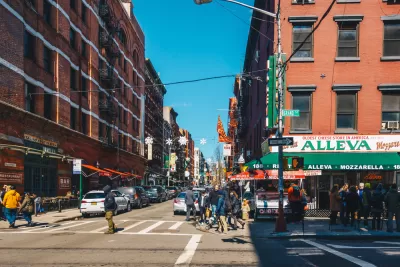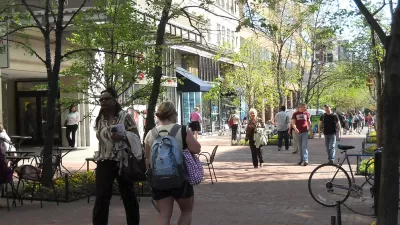New research sheds light on how the brain responds to urban environments and architecture.

The built environment, writes Jared Green for the American Society of Landscape Architects, "is directly linked with happiness and well-being, and too often urban environments fail to put people at ease." Justin Hollander, professor of urban and environmental planning and policy at Tufts University, says "we are deeply influenced by our surroundings" thanks to our "automatic (non-conscious) response to shapes, patterns, and colors."
"As we now understand, humans are drawn to landscapes that provide a refuge, a sense of safety, and prospect, a view of the entire scene, which supports that sense of safety. Storytelling is also important in landscapes, whether they are gardens, parks, or streetscapes. Humans are drawn to landscapes that provide clear sequences." In his experiments, Hollander uses eye-tracking technology to quantify the effects of various environments on the human brain. "Hollander said eye tracking software shows that New Urbanist-style communities, which have homes closer to the street; traditional architecture that mimic faces; and sidewalks all “encourage walking.” If a pedestrian can see a sequence — one, two, three, four homes in a row — they are more likely to want to walk down that row."
"According to Nikos Salingaros, professor of mathematics, architecture, urban, and complexity theory at the University of Texas at San Antonio, architects today are wed to a style rooted in 1920s Germany — the Bauhaus — that creates an unhealthy built environment" composed of "stylistically irrelevant glass boxes" that create cognitive stress in the human brain. Salingaros suggests that healthy environments are those that privilege human connectivity and the human scale–"intimate networks that are comfortable to humans." Architect and author Ann Sussman also suggests solutions for mitigating the effects of existing forms. In Somerville, Massachusetts, "the negative impact of the blank concrete wall of a parking garage was mitigated through public art and greenery."
Because "environments that are easier to fixate on cause less cognitive stress" and have a powerful impact on public health, argues Hollander, "planners, landscape architects, and architects have a responsibility to design a built environment that increases well-being."
FULL STORY: New Research: The Built Environment Impacts Our Health and Happiness More Than We Know

Study: Maui’s Plan to Convert Vacation Rentals to Long-Term Housing Could Cause Nearly $1 Billion Economic Loss
The plan would reduce visitor accommodation by 25,% resulting in 1,900 jobs lost.

North Texas Transit Leaders Tout Benefits of TOD for Growing Region
At a summit focused on transit-oriented development, policymakers discussed how North Texas’ expanded light rail system can serve as a tool for economic growth.

Using Old Oil and Gas Wells for Green Energy Storage
Penn State researchers have found that repurposing abandoned oil and gas wells for geothermal-assisted compressed-air energy storage can boost efficiency, reduce environmental risks, and support clean energy and job transitions.

Santa Barbara Could Build Housing on County Land
County supervisors moved forward a proposal to build workforce housing on two county-owned parcels.

San Mateo Formally Opposes Freeway Project
The city council will send a letter to Caltrans urging the agency to reconsider a plan to expand the 101 through the city of San Mateo.

A Bronx Community Fights to Have its Voice Heard
After organizing and giving input for decades, the community around the Kingsbridge Armory might actually see it redeveloped — and they want to continue to have a say in how it goes.
Urban Design for Planners 1: Software Tools
This six-course series explores essential urban design concepts using open source software and equips planners with the tools they need to participate fully in the urban design process.
Planning for Universal Design
Learn the tools for implementing Universal Design in planning regulations.
Ascent Environmental
Borough of Carlisle
Institute for Housing and Urban Development Studies (IHS)
City of Grandview
Harvard GSD Executive Education
Toledo-Lucas County Plan Commissions
Salt Lake City
NYU Wagner Graduate School of Public Service





























